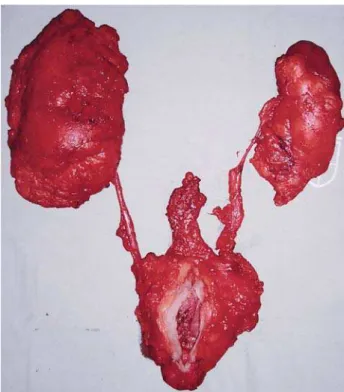560
Urinary Exenteration for Synchronous Transitional Cell Carcinoma Case Report
International Braz J Urol Vol. 32 (5): 560-562, September - October, 2006
Complete En Bloc Urinary Exenteration for Synchronous
Multicentric Transitional Cell Carcinoma with Sarcomatoid
Features in a Hemodialysis Patient
Tiberio M. Siqueira Jr, Evandro Falcao, Tiberio M. Siqueira
Memorial Sao Jose Hospital, Recife, Pernambuco, Brazil
ABSTRACT
The incidence of transitional cell carcinoma (TCC) in patients submitted to hemodialysis is low. The presence of TCC with sarcomatoid features in this cohort is even scarcer. Herein, we describe a very rare case of synchronous multicentric muscle invasive bladder carcinoma with prostate invasion in a hemodialysis patient, submitted to complete en bloc urinary ex-enteration.
Key words: hemodialysis; urologic neoplasms; carcinosarcoma; bladder; surgery
Int Braz J Urol. 2006; 32: 560-2
CASE REPORT
A 58 years-old white obese man, submitted to a hemodialysis program due to diabetic nephropa-thy, was referred to our department because of pain-less macroscopic hematuria.
Ultrasound and cystoscopy revealed multiple pediculated and sessile lesions in different parts of the bladder. Pre-operative computed tomography (CT) scan showed no extravesical dissemination or node enlargement.
The patient was submitted to a deep transure-thral resection of bladder tumor (TURb) in part of the visible masses, but not all due to its extent. Patho-logic examination showed high-grade urothelial tu-mor, with invasion of the lamina propria layer only.
Based on the pathological report, the patient was submitted to en bloc urinary exenteration asso-ciated to extended pelvic lymphadenectomy (Figure-1). Operative time, blood loss and hospital stay were
300 minutes, 770 mL and 5 days, respectively. No complications were observed.
Final pathology evidenced high-grade muscle invasive bladder carcinoma with extravesical inva-sion to adipose tissue and bladder neck. Prostate in-vasion by the urothelial tumor was observed, present-ing sarcomatoid features (Figure-2). Surgical margins, kidneys, ureters and nodes were free of tumor. No chemoteraphy treatment was administered.
On postoperative month 6, CT scan showed multiple lesions in both lungs and brain. Pleural bi-opsy evidenced bladder tumor metastasis. Six days later, the patient died of metastasis complications.
COMMENTS
561
Urinary Exenteration for Synchronous Transitional Cell Carcinoma
Recently, Wu et al. (2) reported the largest experience ever published with hemodialysis patients presenting TCC. In all 30 cases, the initial diagnosis Figure 1 – Surgical specimen shows the complete en bloc re-moval of the entire urinary tract and prostate, associated to ex-tended pelvic lymphadenectomy.
presented gross hematuria as a cause. According to fi-nal surgical status, the patients were divided in 6 dif-ferent groups. Groups 1 and 2 had total urinary ex-enteration (11 cases). Groups 3 and 4 had uni or bilat-eral nephroureterectomy with bladder cuff excision (13 cases). Group 5 had only TURb and group 6 with one case of radical cystectomy and ileal conduit.
The authors observed 100% incidence of re-currence rate in the patients of group 2, leading to a stepwise total exenteration. Likewise, the recurrence rate in groups 3,4 and 5 were 2.3, 1.7 and 1.8 times, respectively. Finally, the treatment administered to patients in group 6 was considered not ideal, due to the inability in monitoring recurrences. The conclu-sion was that no matter what the tumor grade, stage or location, the treatment of choice for hemodialysis patients presenting TCC is total urinary exenteration. In our case, every definitive forms of treat-ment were discussed with the patient. Besides that, the low residual urinary output led us choose the to-tal “en bloc” urinary exenteration. For our surprise, final pathology showed a MIBC with sarcomatoid features and prostate invasion.
No chemotherapy was prescribed, based on the final pathological report and the patient’s clinical status. The rapid progression to lungs and brain metastasis, show the aggressiveness of the tumor and made us wonder if chemotherapy would avoid this final course.
Figure 2 – Pathologic analysis. A) High grade muscle invasive bladder carcinoma with extravesical invasion to adipose tissue and bladder neck. B) Prostate invasion by urothelial tumor presenting sarcomatoid features (HE, X133).
562
Urinary Exenteration for Synchronous Transitional Cell Carcinoma
This case corroborates with the need to evalu-ate every patient in hemodialysis presenting hema-turia in order to diagnose TCC. To the best of our knowledge, this is the first report of synchronous multicentric MIBC with sarcomatoid features and prostatic invasion that is treated by total “en bloc” urinary exenteration. Depending on clinical status, chemotherapy should be considered.
ACKNOWLEDGEMENT
To Dr. Adonis Carvalho for pathological ex-amination and manuscript review.
CONFLICT OF INTEREST
None declared.
REFERENCES
1. Giacchino F, Formica M, Quarello F, Bonello F, Piccoli G: High incidence of cancer in uremic patients. Clin Nephrol. 1985; 23: 265-6.
2. Wu CF, Shee JJ, Ho DR, Chen WC, Chen CS: Differ-ent treatmDiffer-ent strategies for end stage renal disease in patients with transitional cell carcinoma. J Urol. 2004; 171: 126-9.
Accepted after revision: February 20, 2006
Correspondence address: Dr. Tibério M Siqueira Jr
